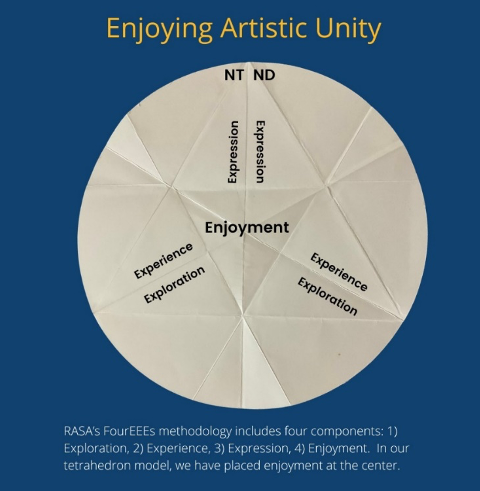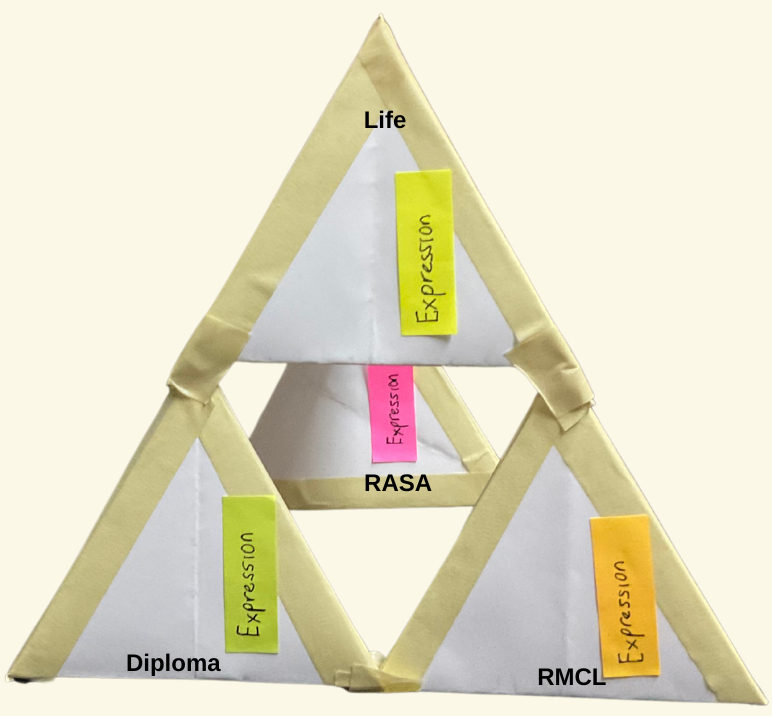Storytelling is one of the most enjoyable Theater Arts for Holistic Development (TAHD) experiences for me. I started my TAHD story listening and narrating journey with Ms. Usha Sankaran, Senior Faciliator (RASA). Then, I started learning dance from Sri Ujwal Jagadeesh, Senior Faculty and Artist at the Ramana Maharshi Center for Learning, in October 2022. Ujwal anna told me stories throughout each class. Stories were one of the most enjoyable parts of the class for me. I used to eagerly wait for the class so I could listen to stories. Soon, I became interested in narrating stories. I narrated my first story on December 2, 2022 (my 25th birthday) at an online event. I continued narrating stories. I recorded them and shared them in my Youtube channel.
Storytelling and Abhinaya
In TAHD classes, storytelling is enjoyable because of the use of abhinaya. In Indian natya, there are four forms of abhinaya or expression. These include body language, speech, attire and props, and emotional expression. Body language is called angika, speech is called vacika, attire and props are called aharya, and emotional expression is called satvika.
My goal is to narrate and record a story every month. In January, I have used all four forms of abhinaya as explained below.
Story of the Month: Rishi Story
My first story of 2024 is about the rishis of Daruka Forest.
https://youtu.be/-Uqu1U2puTU?si=_Q6reG6UX0tncnWZ
When I first heard the rishi story, I was reminded of Hiranyakashyapu in the Prahalada story, one of my favorite stories.
Once there were many rishis in the Daruka Forest who were proud of themselves like Hiranyakashipu was proud of himself. They thought they could create, protect and destroy anything, so Shiva wanted to teach them a lesson just like Narasimha wanted to teach Hiranyakashipu a lesson. Shiva came to the forest as a mendicant. The rishi patnis looked at the mendicant. The rishis then got angry. They said they are going to destroy the mendicant. They created a ferocious tiger. The tiger took two huge steps but Shiva tore the tiger’s skin and wore it. The rishis were very angry. They tried poisonous snakes, a ball of fire, and a demon. However, the rishis failed to destroy the mendicant. This reminded me of how Hiranyakashipu failed to destroy Prahalad even though he tried in many ways. The mendicant smiled at the demon, made him fall on the ground, and started dancing on him. The message of those stories is not to be proud.
The message of the rishi story is to not be proud. We must surrender to God, offer our actions to God, and find our path to happiness.
Abhinaya in the Rishis of Daruka Forest Story
I used all four forms of abhinaya as explained below:
- Angika Abhinaya
In this story, I used whole body movement to portray each character. In my earlier stories, I have used hastas or hand gestures but not whole-body movement.- Positions
I chose three positions when acting Shiva, rishis, and the rishipatnis. When I act the rishis, I am in the centre stage. When I act Shiva, I am on one side. When I act the rishipatnis, I am on another side.
- Movement
When we act, movement of the character is affected by people’s position. For example, when the tiger and serpents move from the rishi to Shiva, they move from the centre to side where Shiva is standing.
- Positions
- Vacika Abhinaya
Vacika abhinaya or speech is very important for storytelling. Since 2020, Ms. Usha Sankaran has been coaching me on storytelling. I have learned how to slow down, speak clearly and speak with expression. Each storytelling project helps me practice these skills. - Aharya Abhinaya
I chose to put a kurta for this story. My mother and I also built a forest using tree blocks and scarves. I used these props when I was in elementary school. I brought them to Bangalore so I can play with them with Ishaan. We created the scene for fun. - Satvika Abhinaya
Expressions are very important for storytelling. We convey expression through body language and through speech.
These four forms of abhinaya make storytelling enjoyable. I enjoyed narrating the story. I hope you enjoy the story.
Visualizing my Journey to Storytelling
In an earlier post, I had presented a circle model for Theater Arts for Holistic Development. As seen in the picture, there is a small triangle in the centre. We label this enjoyment to represent the idea that TAHD is about people (neurotypical and neurodivergent) enjoying experiences together. I used this circle model to build a more detailed model of my journey.

In the circle, the bottom triangle has exploration (trying something new) and experience (being immersed in a more familiar activity). Both NDs and NTs are engaged in explorations and experiences. However, they may learn and communicate differently, so their explorations and experiences might be different.
The final component is expression. After initial exploration and experience, individuals engage in creative expression. Again, NDs and NTs can express themselves differently.
My Journey
I folded four circles as shown above to create a tetrahedron for four types of experiences. The three tetrahedra at the bottom are: 1) learning dance in my Bharatanatyam diploma course, 2) learning dance at RMCL, and 3) theatre experiences at RASA.

Expression happens in all three places and helps me express myself in life. Storytelling is one activity in my daily life that builds on my diploma, RMCL, and RASA experiences.
Parent Note:
Parents of ND children are typically worried about speech. Many parents express concerns about the development of speech. However, communication is more than speech. The four forms of abhinaya in Indian natya provide a useful way of thinking about communication in life! Ananth has become more aware of the need for each of the four forms of abhinaya. He practices all four forms through his TAHD experiences daily. The process of learning by imitation has also been highly effective for Ananth. Many ND children have difficulty with imitation. TAHD has provided daily opportunities for imitating not just body movements but also for oro-motor imitation through storytelling. While Ananth and I wrote the script for most of the later stories, his earlier stories were ones that he had narrated numerous times in dance class with Ujwal.

One Response
So well explained. Was able to see how dance is making Ananth so environmentally present and explore emotions, story telling and then drawing a parallel with Prahlad story so much of memory retrieval and inferencing. A prerequisite for effective communication..loved it…Thank you so much for this insight..🥰